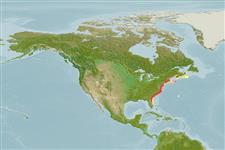>
Eupercaria/misc (Various families in series Eupercaria) >
Sciaenidae (Drums or croakers)
Etymology: Cynoscion: Greek, kyon = dog + Greek, odous = teeth + Greek, skion, skiaina = barbel, red mullet (Ref. 45335).
More on authors: Bloch & Schneider.
Environment: milieu / climate zone / depth range / distribution range
Sinh thái học
Biển; Thuộc về nước lợ gần đáy; Ở đại duơng, biển (Ref. 51243); Mức độ sâu 10 - 26 m (Ref. 54407). Subtropical; 17°C - 27°C (Ref. 54461); 47°N - 27°N, 82°W - 59°W
Western Atlantic: Nova Scotia, Canada to northern Florida, USA. Introduced in Europe (Ref. 122657).
Length at first maturity / Bộ gần gũi / Khối lượng (Trọng lượng) / Age
Maturity: Lm 17.9, range 14 - 22.5 cm
Max length : 98.0 cm TL con đực/không giới tính; (Ref. 40637); common length : 50.0 cm TL con đực/không giới tính; (Ref. 3702); Khối lượng cực đại được công bố: 8.9 kg (Ref. 40637)
Các tia vây lưng cứng (tổng cộng) : 11; Các vây lưng mềm (tổng cộng) : 25 - 29; Tia cứng vây hậu môn: 2; Tia mềm vây hậu môn: 11 - 13. Body greenish grey above and silvery below, back with small spots forming undulating dotted lines. Pelvic fins and anal fin yellowish other fins pale, sometimes with a yellowish tinge. Inside of opercle dark, visible externally. Mouth large, oblique, lower jaw projecting. Upper jaw with a pair of large canine-like teeth at tip. Chin without barbels or pores. Snout with only 1 marginal pore. Gas bladder with a pair of nearly straight, horn-like appendages. Soft portion of dorsal fin covered with small scales up to 1/2 of fin height (Ref 51721).
Occurs usually in shallow coastal waters over sand and sandy mud bottoms. Juveniles are euryhaline. During summer the fish move to their nursery and feeding grounds in river estuaries. Feeds mainly on crustaceans and fishes. Oviparous, with high fecundity (Ref. 54406). The species leave estuaries during the fall when water temperatures decrease, but are also known to overwinter in these areas. It has been reported that the fish cease feeding and die when the water temperature reaches 7.9 deg C and 3.3 deg. C, respectively (Ref. 122657). Utilized fresh and frozen; eaten steamed, pan-fried, broiled, microwaved and baked (Ref. 9988).
Robins, C.R. and G.C. Ray, 1986. A field guide to Atlantic coast fishes of North America. Houghton Mifflin Company, Boston, U.S.A. 354 p. (Ref. 7251)
IUCN Red List Status (Ref. 130435)
Threat to humans
Harmless
Human uses
Các nghề cá: Tính thương mại; cá để chơi: đúng; Bể nuôi cá: Bể cá công cộng
Các công cụ
Special reports
Download XML
Các nguồn internet
Estimates based on models
Preferred temperature (Ref.
123201): 7.2 - 24.9, mean 12.7 °C (based on 172 cells).
Phylogenetic diversity index (Ref.
82804): PD
50 = 0.5000 [Uniqueness, from 0.5 = low to 2.0 = high].
Bayesian length-weight: a=0.00759 (0.00663 - 0.00869), b=3.06 (3.04 - 3.08), in cm total length, based on LWR estimates for this species (Ref.
93245).
Mức dinh dưỡng (Ref.
69278): 3.8 ±0.2 se; based on diet studies.
Thích nghi nhanh (Ref.
120179): Trung bình, thời gian nhân đôi của chủng quần tối thiểu là 1.4 - 4.4 năm (K=0.26-0.3; Fec = 45,000).
Prior r = 0.30, 95% CL = 0.20 - 0.46, Based on 1 full stock assessment.
Fishing Vulnerability (Ref.
59153): Moderate to high vulnerability (45 of 100).
Climate Vulnerability (Ref.
125649): High vulnerability (58 of 100).
Nutrients (Ref.
124155): Calcium = 57.1 [32.9, 114.6] mg/100g; Iron = 0.985 [0.510, 1.744] mg/100g; Protein = 19.1 [17.6, 20.8] %; Omega3 = 0.286 [0.169, 0.468] g/100g; Selenium = 23 [12, 48] μg/100g; VitaminA = 11.8 [3.9, 41.6] μg/100g; Zinc = 0.635 [0.458, 0.956] mg/100g (wet weight); based on
nutrient studies.
